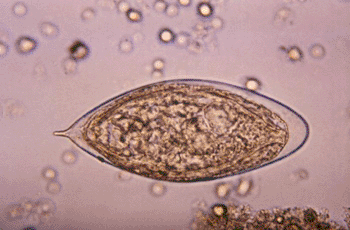Molecular Urine Test Validated for Schistosomiasis
By LabMedica International staff writers
Posted on 16 Jan 2012
Urogenital schistosomiasis in chronically infected adults can be diagnosed by the detection of parasite specific DNA fragments. Posted on 16 Jan 2012
The sensitivity and specificity of three tests have been evaluated for the viable infection of Schistosoma haematobium in the urogenital tract, which included a polymerase chain reaction hematuria, and the presence of parasite eggs.

Image: Schistosoma haematobium egg (Photo courtesy of the CDC).
A team of collaborating scientists under the auspices of those at Johns Hopkins University (Baltimore, MD, USA) collected over 400 urine samples from adult volunteers in an endemic area in Western Nigeria. These were assessed for hematuria then filtered in the field, the filter papers dried and later examined for eggs and DNA. The results were stratified according to sex and age and subjected to Latent Class analysis.
The DNA was precipitated and concentrated using the Qiagen QIAmp (Qiagen; Germantown, MD, USA) mini- kit. The extracted DNA was used for PCR amplification. The primers were designed to amplify the 121 bp tandem repeat restriction endonuclease from Deinococcus radiophilus (Dra-1) sequence of S. haematobium. Each urine sample was tested with a Hemastix (Bayer; Elkhart, IN, USA) test strip to detect hematuria.
The PCR test indicating the presence of Dra1 DNA fragments in males was 100% for both sensitivity and specificity. This exceeded hematuria with a sensitivity and specificity of 87.6% and 34.7%, respectively, while the detection of eggs, the sensitivity was 70.1% and specificity was 100%. There were similar results for the females except the specificity of the hematuria was 77.0%.
To test the effect of parasite clearance on the persistence of Dra1 fragment, a group of 55 persons who were positive either for presence of parasites eggs and/or DNA in the urine, were followed up two weeks after treatment with praziquantel. Of these 26 (47.3%) were positive for parasite eggs and 42 (76.4%) were positive for DNA. None of these people were positive for eggs or parasite specific DNA in the follow up.
The authors concluded that the molecular test is extremely promising for the diagnosis of urogenital schistosomiasis and should also be useful in field studies as it will be able to reveal infections in people frequently presumed to be uninfected. The PCR test indicated the presence of schistosomes in 10.7% of adults who did not pass eggs in urine specimens. The study was published online on January 3, 2012, in the journal Public Library of Science Neglected tropical Diseases (PLoSNTD).
Related Links:
Johns Hopkins University
Qiagen
Bayer










 (3) (1).png)



